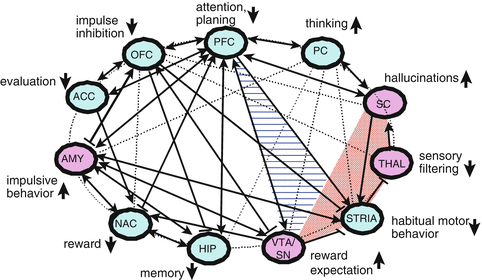Fig. 1
The multi-level approach in systemic neuropsychiatry – top-down deconstructing analysis by biotechnologies and bottom-up reconstructing synthesis by computer-based modelling and simulations
Additionally, neuropsychiatry also has to tackle the basic problem to relate mental phenomena to brain mechanisms (brain-mind problem). Also behaviouristic psychopathology still has to admit that subjective experience is the essential basis of mental disorders: In various stages of mental illness, the patients report strange experiences that in many cases cannot be proved by objective tests (e.g. stupor in depression and schizophrenia). Regarding this, mental disorders roughly can be characterized as an imbalance or dissociation of conscious experience regarding states and processes of cognition and emotion and their subfunctions.
2.1 Schizophrenia as a Systemic Mental Disorder
Schizophrenia is characterized by a complex symptomatology with a high variation of the clinical manifestation in each individual patient [3]. For instance, symptoms like dysfunctions of perception (hallucinations), thought disorders and delusions are very significant. Additionally, ambivalence, autism and affective disorders are observed. All these symptoms are dissociated, which is a basic feature of schizophrenic information processing [4].
Regarding this complexity of symptoms, a systemic approach of modelling psychopathology should focus on a few symptoms, and should not claim to describe the whole disease [5]. In line with this, multi-level modelling of neurobiological data on deficiencies of working memory functions is a fruitful example [6, 7].
For our aim to understand psychiatric illnesses by a system theoretic framework, it is important to transform the symptoms into a quantitative time-related language of functions and dysfunctions so that it is possible to match this type of characterization of the symptomatology of schizophrenia to the activity patterns that are obtained by neurobiological methods: For instance, a hallucination can be defined as a stimulus-free perception that is uncoupled from a sensory system. In this case, a hyperreactivity to sensory stimuli can be observed objectively (reduced prepulse inhibition;[8]). In neurobiological terms this function corresponds to a spontaneous activity or a hyperreactivity of a local perceptual network (e.g. temporal cortex) that exhibits a too strong self-activation compared to the strength of the self-inhibition. Also thought disorders can be understood as a “too many” or “too few” branches of the sequence of the thoughts. Also a too weak or too strong and too short or too long persistence of information in the working memory buffer can be the basis of a dysfunctional working memory function [6, 7; comp. 9].
At present, there is no complete transformation of psychopathological terms into some sort of a functionalistic systemic language as it was demonstrated here. However, this reconceptualization of basic categories of psychopathology and also the construction of a systemic concept of mental functions could be one way for theoretical psychiatry to provide a better match with neurobiological data (isomorphic relation), at least on a micro-anatomical level. Mental functions correspond to local and total brain functions and not only to functions of single neurons or to gene functions.
2.2 Schizophrenia as a Neural Network Disorder
Here we start with a vague concept of the global brain as a neural network, assuming that nearly every macroanatomically defined brain area is directly connected with each other. In this view, we focus on 11 components that are frequently mentioned in publications about relevant schizophrenic symptoms. Here we represent some of their relevant connections (Fig. 2). Although the Human Connectome Project is recording the connectivity of the whole brain [10], we reduce this complexity in order to demonstrate some conceptual and methodological issues: In this global framework some essential models of the schizophrenic brain circuitry are integrated and can be seen as models of subsystems of the whole network of supraregional circuits (Fig. 2). For instance, in the history of neurobiological explanation of schizophrenia one of the first successful hypothetical models was proposed by Arvid Carlsson [11, 12]. In this model, Carlsson proposed a circular dopamine-driven dysfunction: a hyperactivity of the dopamine system that starts in the brain stem (substanzia nigra, SN and ventral tegmental area, VTA) and very strongly inhibits the “striatal complex” (here: STRIA) via inhibiting D2 receptor activation. From here, GABA-based inhibitory projections start to the thalamus (THAL) that provides input for the sensory (visual and auditory) cortices (SC). These (and other) cortical areas exhibit activating projections back to the striatal complexes. In case of schizophrenia, the striatal inhibitory output is weak so that thalamus is hyperactively driving the sensory cortices (Fig. 2a). Several years later a “corticocentric” conception of the neural sources of schizophrenic symptoms was proposed by Daniel Weinberger and his co-workers [13]: Functionally weak prefrontal cortical projections down to the brain stem would not be able to inhibit the up-stream dopaminergic projections to the striatum and also to prefrontal cortex so that these projections exhibit a hyperactivation of the D2 receptors. In prefrontal cortex a pathological functional dominance of D2 receptors in relation to D1 receptors could evoke a weak working memory function (too much distraction). Additionally, imaging studies using path analysis found that a weak connectivity between frontal brain areas and temporal brain areas are typical for schizophrenia and could explain other cognitive impairments (not depicted in Fig. 2; [14]). Reviewing such articles in detail, a realistic picture of all peculiarities of the “dysfunctionally connected” schizophrenic brain network could be constructed.









